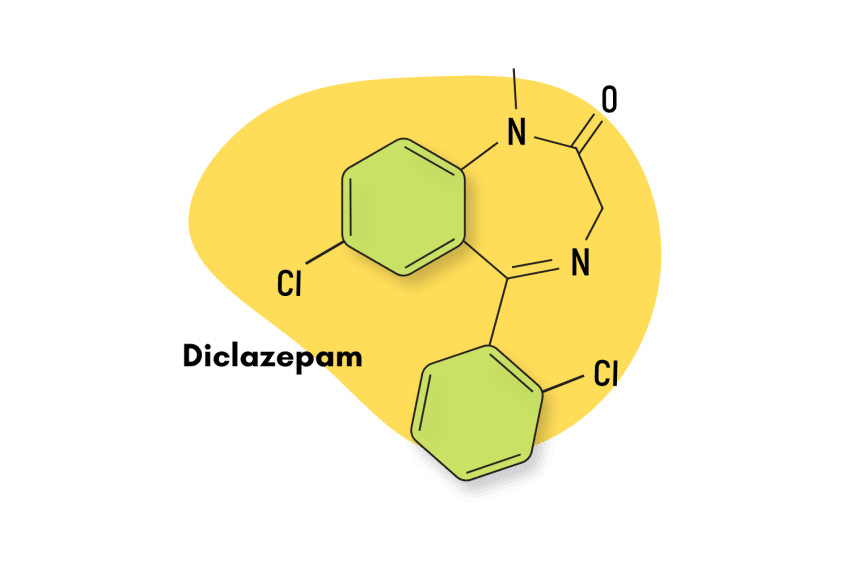Avizafone Fact Sheet & Harm Reduction Guide

Also known as Pro-Diazepam, avizafone is, as its name suggests, a water-soluble prodrug for diazepam, one of the most clinically successful benzodiazepines on the market.
Prodrugs are compounds that may or may not have pharmacological properties of their own but are instead converted into the active form by the liver.
Once avizafone is ingested, enzymes in the liver turn the compound into diazepam (AKA Valium).
Strangely enough, the primary clinical use of avizafone has little to do with diazepam. Instead, it’s used as an antidote to poisoning stemming from organophosphate nerve agents like sarin gas, tabun, and soman [1]. It was initially developed by the French military to eliminate battlefield casualties caused by these destructive nerve agents.
Avizafone Specs
| Status | Not Used |
| Common Dosage | Unspecified |
| PubChem ID | 71968 |
| CAS# | 65617-86-9 |
IUPAC Name
(2S)-2,6-diamino-N-{[(2-benzoyl-4-chlorophenyl)methylcarbamoyl]methyl}hexanamide
Metabolism
An aminopeptidase hydrolyzes Avizafone to liberate lysine and diazepam. The drug rapidly converts to diazepam because of enzymatic activation and deamination of metabolic byproducts in the blood [2].

Benzodiazepine Dosage Equivalency Calculator
**Caution:** Benzodiazepines have a narrow therapeutic window. Dose equivalents may not be accurate in higher doses.
This calculator does not substitute for clinical experience and is meant to serve only as a reference for determining oral benzodiazepine equivalence.
Please consult a medical practitioner before taking benzodiazepines.
How Does Avizafone Work?
It’s been known for several years that benzodiazepine compounds can block seizures induced by organofluorophosphates. However, the benzodiazepine agent alone would not be enough to effectively counteract a poisoning of this kind. It would be necessary to administer a cocktail consisting of three drugs: an anticholinergic drug, an acetylcholinesterase reactivator, and an anticonvulsant (the benzodiazepine) [2].
In this sense, avizafone is never administered by itself; it is always used in conjunction with two other compounds. For these situations, the Sedat Company created a device known as the French Army Auto-Injector, which contains 2 mg of atropine, 350 mg of pralidoxime, and 20 mg of avizafone.
Diazepam achieves a higher maximum concentration when injected from a prodrug than if taken normally, and this is important because time is crucial to successfully treat a poisoning. The water-soluble nature of avizafone is also highly important in this regard.
Is Avizafone Safe? Risks & Side Effects
As a prodrug of diazepam, avizafone carries certain risks inherent to all benzodiazepine compounds. However, when we examine the clinical context in which avizafone use takes place, fretting over its risks makes little sense. In simple terms, any possible side effects stemming from avizafone use pale compared to the effects of poising by nerve agents.
And in terms of avizafone’s abuse liability, this drug is not available on the market, and there is no significant record of black-market avizafone abuse.

Side Effects of Avizafone
Avizafone is metabolized into diazepam very quickly, which means that what we’re trying to assess here is diazepam’s side effects.
The FDA has identified the following side effects as a result of the related substance, diazepam:
- Antegrade amnesia
- Anxiety
- Blurred vision
- Changes in libido
- Changes in salivation
- Confusion
- Constipation
- Depression
- Diplopia
- Dizziness
- Dysarthria
- Elevated transaminases and alkaline phosphatase
- Gastrointestinal disturbances
- Hallucinations
- Headache
- Hypotension
- Incontinence
- Insomnia
- Irritability
- Nausea
- Skin reactions
- Slurred speech
- Tremors
- Urinary retention
- Vertigo
Avizafone Withdrawal & Dependence
Physical dependence and withdrawal symptoms stemming from avizafone use should not be a meaningful concern. Certain benzodiazepines can engender dependence within a time frame as short as seven to 10 days, but in the case of single-use benzodiazepines like flumazenil or avizafone, the possibility of developing dependence is just not there.

Harm Reduction: Avizafone
The unique nature of avizafone also implies there is little to be gained by assessing it from a harm reduction lens.
So instead, we would rather remind everyone of the basic harm reduction recommendations applicable to more traditional benzodiazepines:
Benzodiazepine Harm Reduction Tips
- 🥣 Don’t mix — Mixing benzodiazepines with other depressants (alcohol, GHB, phenibut, barbiturates, opiates) can be fatal.
- ⏳ Take frequent breaks or plan for a short treatment span — Benzodiazepines can form dependence quickly, so it’s important to stop using the drug periodically.
- 🥄 Always stick to the proper dose — The dosage of benzos can vary substantially. Some drugs require 20 or 30 mg; others can be fatal in doses as low as 3 mg.
- 💊 Be aware of contraindications — Benzodiazepines are significantly more dangerous in older people or those with certain medical conditions.
- 🧪 Test your drugs — If ordering benzos from unregistered vendors (online or street vendors), order a benzo test kit to ensure your pills contain what you think they do.
- 💉 Never snort or inject benzos — Not only does this provide no advantage, but it’s also extremely dangerous. Benzos should be taken orally.
- 🌧 Recognize the signs of addiction — Early warning signs are feeling like you’re not “yourself” without the drug or hiding your habits from loved ones.
- ⚖️ Understand the laws where you live — In most parts of the world, benzodiazepines are only considered legal if given a prescription by a medical doctor.
- 📞 Know where to go if you need help — Help is available for benzodiazepine addiction; you just have to ask for it. Look up “addiction hotline” for more information where you live. (USA: 1-800-662-4357; Canada: 1-866-585-0445; UK: 0300-999-1212).
Avizafone Drug Interactions
As a benzodiazepine with CNS-depressant properties, avizafone could be deadly when combined with other compounds like opioids or alcohol. Luckily, the unique nature of avizafone means there’s little chance of any such combination taking place.

Avizafone Contraindications
As a prodrug of diazepam, avizafone is contraindicated for the same conditions.
Avizafone Dosage
Within the context of an antidote for organophosphate poisoning, the proper dose for avizafone is 20 mg.
Similar Benzodiazepines
In terms of its clinical objective, there aren’t many benzodiazepine compounds to which we could compare avizafone, but there are compounds that are meaningfully related to it in other ways.
Flumazenil
Flumazenil is a benzodiazepine receptor antagonist used in a comparable way to avizafone.
Flumazenil is also a single-use compound meant to be injected, but instead of treating nerve agent poisoning, flumazenil is used to revert the effects of benzodiazepine overdoses.
Flumazenil can do this because, as a receptor antagonist, it interacts with GABA receptors in the opposite way that most benzodiazepines do and thus works to lessen the effects of benzodiazepines in the body.

Diazepam
The comparison here is evident given that avizafone is a prodrug for diazepam (AKA Valium) and converts into it almost instantly. The pharmacological properties of diazepam help stop organophosphate poising, but it’s the pharmacokinetics of avizafone that allow these effects to be effective.

Natural Alternatives to Benzodiazepines
Natural alternatives to benzodiazepines exist! If you’re wondering if benzodiazepines might be too much of a risk, then why not give one of the following compounds a try?
Kratom
You might’ve heard about kratom already, as this tropical evergreen plant has recently exploded in popularity. Indeed, prescription drug users of all kinds have begun switching over to kratom due to its incredible suite of pharmacological benefits.
Kratom is a spectrum drug, which means that as the dosage increases, the effects begin to change. In low doses, kratom is a stimulant and euphoric, while in mid-to-high doses, its an anxiolytic, analgesic, and sedative [3].
The only concern is that since kratom interacts with the body’s opioid receptors, it can become dangerous if mixed with other CNS-depressant compounds.

St. John’s Wort
St. John’s wort is a flowering shrub that also boasts pharmacologic benefits, although not quite as diverse as kratom’s. St. John’s wort is mainly used as an anxiolytic, although it does have other benefits, like the treatment of menopausal symptoms [4].
However, St. John’s wort can cause dependence if taken in large amounts for an extended period. Additionally, it also interacts with many compounds, so it’s important to speak to a doctor before using it. Nevertheless, it’s effective in treating mild to moderate depression and produces fewer side effects than pharmacological alternatives!

Avizafone FAQs
How is avizafone water-soluble?
Avizafone is the peptide between the open form of diazepam and l-lysine and bears two primary amino functions that can be salified. This quality is what makes the compound water-soluble.
Is there a time limit for the effective application of avizafone?
Yes. Research shows that avizafone must be applied within ten minutes of poisoning to be effective [5].
References
- Karlsson, B., Lindgren, B., Millquist, E., Sandberg, M., & Sellström, Å. (1990). On the use of diazepam and pro-diazepam (2-benzoyl-4-chloro-N-methyl-N-lysylglycin anilide) as adjunct antidotes in the treatment of organophosphorus intoxication in the guinea-pig. Journal of pharmacy and pharmacology, 42(4), 247-251.
- Wermuth, C. G. (Ed.). (2011). The practice of medicinal chemistry. Academic Press.
- Eastlack, S. C., Cornett, E. M., & Kaye, A. D. (2020). Kratom—Pharmacology, clinical implications, and outlook: a comprehensive review. Pain and therapy, 9(1), 55-69.
- Ng, Q. X., Venkatanarayanan, N., & Ho, C. Y. X. (2017). Clinical use of Hypericum perforatum (St John’s wort) in depression: A meta-analysis. Journal of affective disorders, 210, 211-221.
- Clement, J. G., & Broxup, B. (1993). Efficacy of diazepam and avizafone against soman-induced neuropathology in the brain of rats. Neurotoxicology, 14(4), 485-504.








